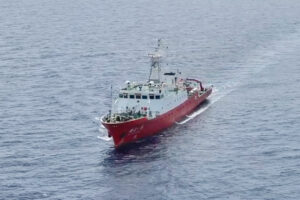
Chinese research vessel still near Sabina Shoal, says Philippine Navy
THE PHILIPPINE Navy on Tuesday said a Chinese research vessel equipped with advanced technology designed for marine environment observation was still near Sabina Shoal, more than a week after it left a major Chinese military outpost in the South China Sea.
Chinese research vessel Ke Xue San Hao’s “zigzag” movement “indicates something else,” and no longer qualified as innocent passage, Navy spokesman Roy Vincent Trinidad told a news briefing.
He added that the Philippine Navy continues to monitor the vessel’s movements because it might be causing environmental damage. China’s reclamation in the South China Sea has reached about 3,000 hectares, he pointed out.
The Chinese Embassy in Manila did not immediately reply to a Viber message seeking comment.
The research vessel left Sanya port on Hainan Island on July 19, two days before the Philippine Department of Foreign Affairs announced it had concluded a deal with China to resume resupply missions to BRP Sierra Madre.
A handful of Filipino soldiers live on the World War II-era ship, which Manila grounded at the shoal in 1999 to bolster its sea claim.
Ke Xue San Hao left Mischief Reef on July 26 and has since passed through several areas including Second Thomas Shoal, Raja Soliman Shoal, Bulig Shoal, Hasa-Hasa Shoal, Abad Santos Shoal and Sabina Shoal.
Sabina is part of the Spratly Islands and falls within the Philippines’ exclusive economic zone (EEZ). It is 123.6 nautical miles from Palawan Island, which is facing the South China Sea.
Mr. Trinidad said the research vessel did not seek permission to do scientific research in the area. “We have checked with the Department of Foreign Affairs, there was no request to conduct marine scientific research.”
“We have to leave it up to our appropriate government agency how to deal with hydrographic surveys or marine scientific research within our [exclusive economic zone],” he added.
The Philippine Coast Guard earlier said the research vessel, which was designed by the Marine Design and Research Institute of China and built by Wuchang Shipbuilding Industry Co., is equipped with advanced technology that “enables comprehensive marine environment observation, detection, sampling and analysis.”
On Saturday, it said the vessel had exhibited irregular automatic identification system (AIS) transmissions while sailing through the northern part of Sabina.
Also on Tuesday, Raymond M. Powell, a fellow at Stanford University’s Gordian Knot Center for National Security Innovation, said China’s largest coast guard ship “The Monster” was still at Sabina Shoal as of Aug. 5.
It was near the Philippine Coast Guard’s 97-meter BRP Teresa Magbanua, which was stationed at the center of the shoal, along with six maritime militia vessels and three smaller militia boats rafted together, he said in an X message, citing satellite imagery.
The Monster ship has turned off its AIS since July 31, he added.
The Armed Forces of the Philippines (AFP) said the number of Chinese vessels it had monitored within the Philippines’ EEZ in the South China Sea from July 30 to Aug. 4 had risen to 122 from 104 a week earlier.
The vessels include 12 ships from the China Coast Guard, three ships from the People’s Liberation Army (PLA) and 106 maritime militia vessels, AFP spokesperson Francel Margareth Padilla told the same briefing.
At Sabina Shoal, there was one China Coast Guard ship, 12 Chinese maritime militia vessels and one Chinese research vessel, she added.
At Scarborough Shoal, there were three China Coast Guard vessels, six maritime militia vessels and one PLA vessel. There were five China Coast Guard vessels and 37 maritime militia ships at Second Thomas Shoal.
Scarborough Shoal is 240 kilometers west of the main Philippine island of Luzon and is nearly 900 kilometers from Hainan, the nearest major Chinese landmass.
Ms. Padilla said there were 37 maritime militia vessels and one China Coast Guard vessel near Philippine-occupied Thitu Island, two Chinese maritime militia vessels near Kota Island, one China Coast Guard vessel and four maritime militia ships near Lawak Island and two PLA vessels and three Chinese maritime militia vessels near Lankiam Cay or Panata Island.
There were four maritime militia vessels at Whitsun Reef, 30 maritime militia vessels near Iroquois Reef and one China Coast Guard vessel near Flat Island, which is part of the Spratly Islands.
A United Nations-backed tribunal based in the Hague in 2016 voided China’s expansive claims in the South China Sea for being illegal. — Kyle Aristophere T. Atienza



